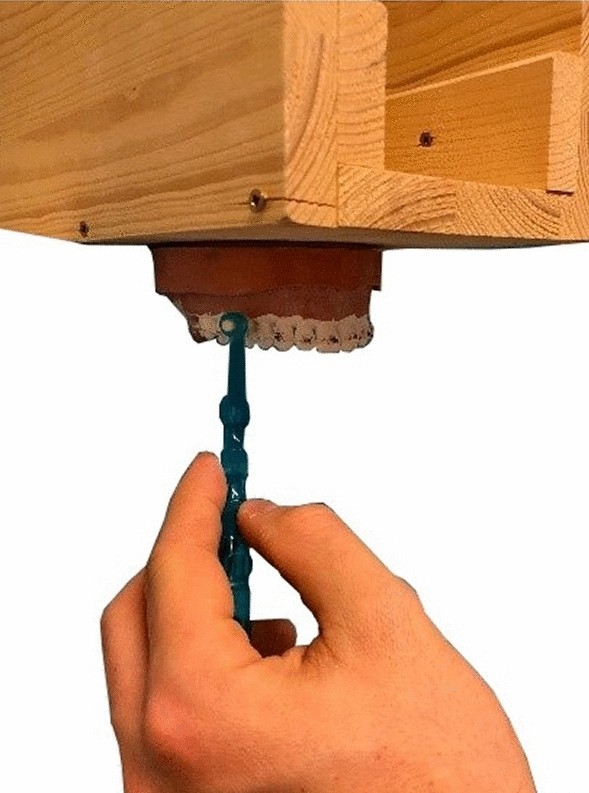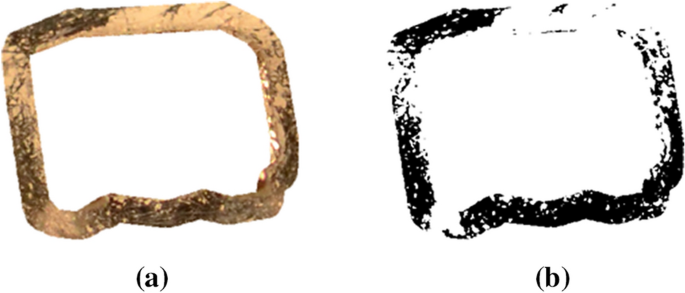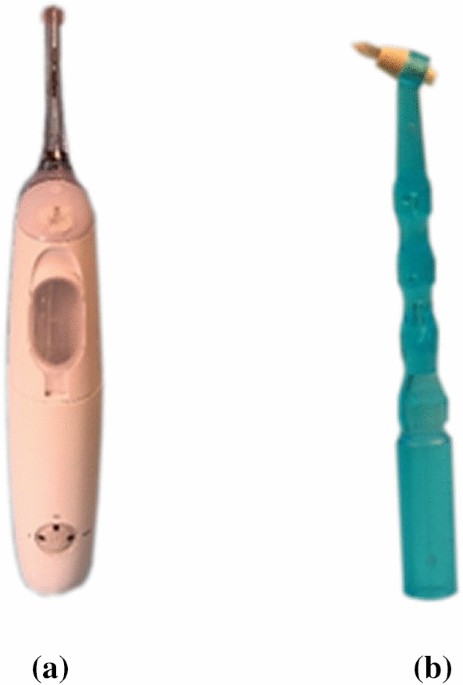The cleaning process was performed on a maxillary (upper jaw) model with full dentition of plastic teeth (KaVo Dental GmbH, Ulm, Germany).
Preparation
First, the buccal (tooth area facing towards the cheek) and the approximal surfaces of the plastic teeth were sandblasted with 110 µm aluminium oxide Korox at 2 bars (Bego, Bremer Goldschlägerein Wilh. Herbst GmbH & Co KG, Bremen, Germany; device: Renfert Classic Plus 3, Renfert GmbH, Hilzingen, Germany). A labelled diagram explaining the dental anatomy of the maxilla can be found online in Supplementary Figure S2. This process led to the adequate adhesion of the black two-component varnish applied to the plastic teeth (DuPont Refinish, Willich, Germany). After drying for 24 h, a second coat was applied. The black varnish provided an ideal contrast to white artificial plaque. Then, brackets (Mini 2000, Straight-Wire, Ormco, Orange, California, USA) were attached to the teeth by superglue (Henry Schein, Instant Fix, Melville, USA), and a wire (Niti-Wire round 0.012 inch, Orthana, Recklinghausen, Germany) was ligated with orthodontic ligatures (Dentalastics Personal, Dentauraum, Ispringen, Germany).
To ensure standardized and repositionable fixation of the teeth for photography, the teeth were placed into a plaster block after each cleaning stage. A total of three blocks were produced for the buccal, mesial (approximal surface directed towards the midline of the face) and distal (approximal surface directed away from the midline of the face) areas (Dento-stone 220, Dentona AG, special superhard plaster type 4, Dortmund, Germany). To make the blocks, the root of each tooth needed to be covered with wax to prevent areas divergence (Modelling wax, Henry Schein, Melville, USA). The teeth were set into plaster 2 cm apart from each other. To ensure an even height and distance, the crown of the tooth was fixed in A-silicone (polysiloxane, Henry Schein, Melville, USA). Twenty millilitres of water was added to the plaster (100 g) and it was stirred with a vacuum mixer (Motova SLA, BEGO AG, Bremen, Germany). Then, the root of each blocked tooth was set into the plaster. To enable easy insertion and removal of the teeth from the block, cavities were milled into the plaster block. Then, the blocks were trimmed to their final shape (Renfert GmbH, Hilzingen, Germany).
To standardize the evaluation, it was important that the artificial plaque did not peel off, to ensure high contrast with the black tooth surface, and that its composition did not change during the trial. A suspension of titanium dioxide (13 g) and isopropyl alcohol (28 millilitres) (VWR International GmbH, Langenfeld, Germany) was used to simulate the plaque. With a magnetic stirrer (IKA-Werke GmbH & Co. KG, Staufen, Germany), the two ingredients were mixed for 30 min, turning them into a viscous compound. Standardized conditions were maintained by using mechanical stirring and constant ingredient mixing ratio. After a resting time of 24 h, the plaque was applied manually to the teeth by one brushstroke with a clean brush. By tapping the tooth on the edge of the table, the plaque spread uniformly over the tooth surface. It was allowed to dry for 4 h. For each cleaning trial, one layer was applied.
Cleaning process
Cleaning was accomplished by the Sonicare AirFloss Ultra HX8431 (Philips GmbH, Amsterdam, Netherlands) or by the sulcus brush I-Prox P (Miradent, Hager & Werken GmbH & Co. KG, Duisburg, Germany) (Fig. 1). Both devices were characterized by the fact that no proximal contact can be bypassed. The spray nozzle of the AirFloss device faces the buccal surface of the approximal area. By pressing a button, water sprays at a speed of 72 km per hour from the buccal to the oral surface facing the mouth cavity. Depending on the mode, one, two, or three spray bursts are applied. The sulcus brush consists of an approximately 14-cm-long handle with a tapered v-shaped brush. A new brush was used for each cleaning process. Cleaning was carried out by rotating movements in the buccal and approximal areas.
The Sonicare AirFloss Ultra HX8431 (a) and the sulcus brush I-Prox P (b) were used for cleaning.
To standardize the cleaning processes, the AirFloss Ultra was always applied in contact with the tooth surface at a constant angle. The use of the devices was performed as recommended in the respective instruction manuals (see Supplementary Document S3). In contrast to a standard toothbrush, the I-Prox P brush is held at a right angle in relation to the buccal and approximal tooth surfaces. Because of the tilted head of the brush (120° angle), this cleaning position allows for gentle cleaning without irritating the gingiva. The brush was used with a contact pressure of two bars, and the application time was managed with a timer.
First, the buccal area was cleaned followed by the mesial and distal approximal surfaces. After each cleaning procedure, the brush of the I-Prox P was replaced to maintain a constant hardness of the cleaning filaments. The AirFloss pressure of the sprays was pre-set and did not change during the trial. Depending on the cleaning routine, the double burst mode was accomplished one (two spray bursts per area) and two times (four spray bursts per area). The nozzle tip of the AirFloss was placed horizontally between two teeth at the gum line while the activation button was pressed to deliver two and four bursts, respectively.
To achieve cleaning as close to reality as possible, the KaVo model was fixed to a special appliance. This setup allowed simulated cleaning of the upper teeth at eye level and from the front as if they were the teeth of the trial operator. Additionally, it prevented the model from moving during the process (Fig. 2).

A specially built appliance was attached to the KaVo model to ensure standardized cleaning.
Every cleaning stage was divided into four groups. Each group was repeated four times leading to a total of 16 cleaning procedures.
The use of the I-Prox P brush for two seconds per area (I-2).
The use of the I-Prox P brush for four seconds per area (I-4).
The use of the AirFloss Ultra with two spray bursts per area (A-2).
The use of the AirFloss Ultra with four spray bursts per area (A-4).
Each cleaning routine (I-2, I-4, A-2, A-4) included the cleaning of four incisors, two canines, four premolars, and four molars (see Supplementary Figure S2). Since only two canines were included in the KaVo model, an extra cleaning stage was carried out by cleaning only the two canine. Cleaning a total of 16 teeth in each cleaning routine and repeating each group four times led to an equal number of 64 evaluated teeth of each tooth type (incisors, canines, premolars, molars). All the cleaned teeth in all four groups totalled 256 teeth.
Photograph editing
After each completed cleaning procedure, the teeth were removed from the KaVo model and placed into the plaster blocks. In a photobooth, photographs were taken by a Canon EOS 60D with an EF-S 18–25 mm IS II lens (Canon GmbH, Krefeld, Germany) at 62.2 cm.
Before applying titanium oxide to the teeth, a total of 12 masks of the buccal and approximal surfaces were produced, defining the areas considered for evaluation (Adobe Photoshop CS5, Adobe Systems Software Ireland Limited, Dublin, Ireland).
After putting the teeth in the plaster blocks, the masks produced in advance were layered on the cleaned photographed areas. The extraction was conducted using Adobe Photoshop CS5. The generated cut-outs were evaluated with the ImageJ software program (National Institutes of Health, Bethesda, USA). By turning them into black-and-white pictures, the cleaned areas (black) were distinguishable from the uncleaned surfaces (white). The ratio of white pixels to the total number of pixels of the mask corresponded to the cleaning efficacy (Fig. 3).

(a) shows the extracted photograph. (b) presents the black-and-white picture of the cleaned, white areas and the uncleaned, black areas.
Outcome measures
The working hypothesis assumed that the AirFloss Ultra would achieve a higher cleaning efficacy than the sulcus brush I-Prox P.
Statistical analysis
To produce significant results, the sample size was estimated with the G* Power 3.1.9.2 program30. A sample size of 32 teeth (16 teeth per group) was analysed with a statistical power of 0.8, an alpha error of 0.05, and an effect size of 1.04.
All data were analysed with the SPSS 25.0 software program (IBM Germany GmbH, Ehningen, Germany). All 256 teeth served as the bases for the statistical analysis. Each area of each tooth (mesial, distal, and buccal) was evaluated, leading to a total of 768 single values. For the descriptive statistics, the minimum, maximum, median, mean, and standard deviation were used. Kolmogorov–Smirnov test identified a normal distribution with an asymptomatic significance value of p = 0.2 for the mesial, distal, and buccal areas in all the cleaning groups. Within groups I-2, A-2, and A-4, a normal distribution with an asymptomatic significance value of p = 0.2 was found. The values of cleaning groups I-4 showed an asymptomatic significance value of p = 0.01. Subsequent ANOVAs and post hoc tests with Bonferroni correction were used to determine the significance between the cleaning groups at a significance level of p = 0.05.


